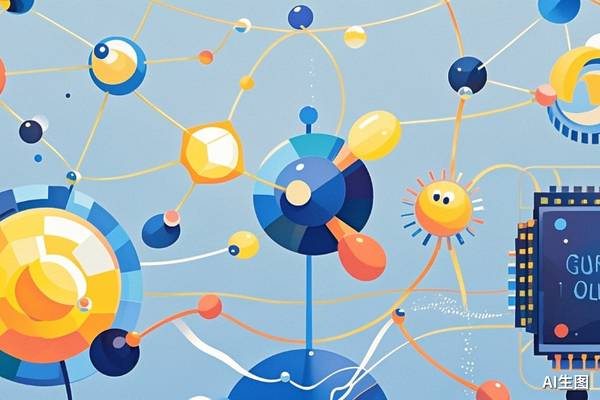Today we continue to focus on quantum computing.
In the previous part, we delved into the technical principles of quantum computing, the bottlenecks in commercialization, and the cutting – edge progress in the field of quantum error correction.
In this part, we will mainly focus on the following questions:
1) What bottlenecks is classical computing currently facing, and why do we need quantum computing?
2) Why is it necessary to pay special attention to quantum computing at the current time?
3) The six technical paths of quantum computing
4) The latest progress and business layouts of leading enterprises
Understanding quantum computing has a relatively high threshold, and the content is quite technical. It is recommended to read it patiently.
(1) Bottlenecks of Classical Computing and Advantages of Quantum Computing
As the manufacturing process approaches the physical limit, the ceiling of classical computing is within sight, and quantum computing is on the horizon.
Firstly, there is the computing bottleneck. The computing power of classical computing grows linearly, while quantum computing can achieve exponential growth in computing power due to the principle of “quantum superposition”.
When dealing with complex problems such as drug molecule simulation, even the most powerful supercomputers today would take hundreds of millions of years to complete the calculations, while quantum computing can solve the problems quickly.
The second problem with classical computing is the quantum tunneling phenomenon.
When electronic components are shrunk to the nanometer scale and the insulating layer is only a few atoms thick, electrons will exhibit the “tunneling phenomenon”, passing through the “wall” and causing leakage, which makes the transistors malfunction. Moore’s Law hits a hard quantum wall.
In superconducting quantum computing, electrons paired as Cooper pairs pass through the Josephson junction via quantum tunneling, so there is no such bottleneck.
The third is the heat dissipation problem.
Landauer’s theorem tells us that for every 1 bit of information erased, at least kT ln 2 of energy must be consumed and dissipated in the form of heat.
Put simply, if we compare a chip to a “shredder”, this theorem means that no matter how advanced your shredder is, as long as you want to shred the paper completely (irreversibly) so that it cannot be reassembled, you must “pay the electricity bill”, and this cost cannot be less than kT ln 2. Moreover, the shredder will get hot after shredding.
After Moore’s Law reaches below 3 nm, the computing density increases significantly, and heat dissipation becomes an inescapable “thermal death” background. It’s like an office filled with constantly – running shredders, turning it into a sauna.
If you want to break through the “thermal wall” limit and continue to improve computing power, there are only two ways: either cool down (which is very expensive) or switch to quantum computing.
Different from classical computing, the way quantum computing processes information is reversible. Entropy does not increase, heat is difficult to generate, and the heat dissipation effect is resolved.
(2) Why Pay Attention to Quantum Computing at the Current Time?
There are two main reasons to pay attention to quantum computing at the current time.
Firstly, countries around the world regard quantum computing as a strategic high – ground for scientific and technological power. In recent years, the investment has been increasing, and key equipment export control measures have been frequently introduced.
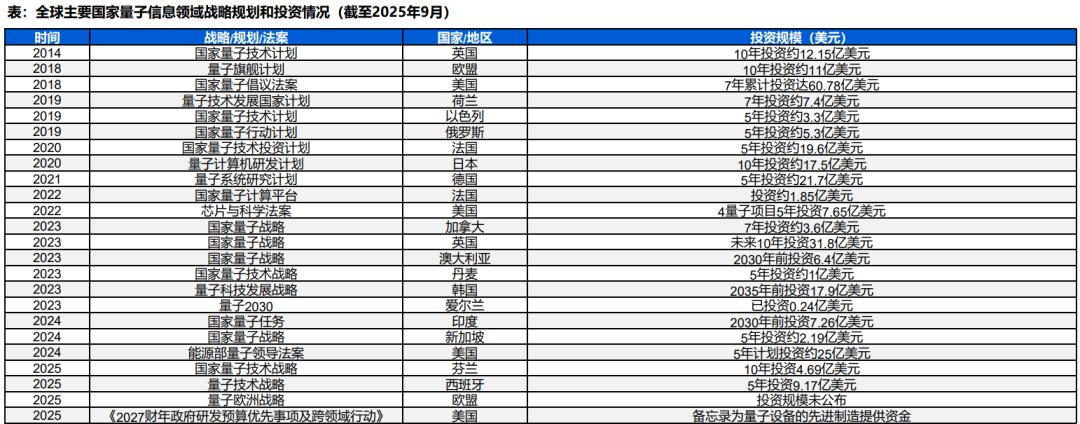
Figure: Quantum computing plans of various countries, Guohai Securities, AlphaEngine
From 2019 to 2025, developed countries in Europe and America have launched a large number of investment bills and strategic plans in the field of quantum computing.
Among them, in the memorandum of government R & D priorities for fiscal year 2027 released by the White House on September 23, 2025, the United States clearly listed artificial intelligence and quantum computing as the top priorities for R & D budget in 2027 and pointed out that the critical turning point for quantum computing to move from the laboratory to industrial applications has arrived. 2027 is an important turning point.
In the past two years, developed countries such as those in Europe, America, and Japan have successively tightened the export of quantum technologies.
Take the dilution refrigerator as an example. In 2022, the United States issued a ban, and the equipment of industry leaders Bluefors and Leiden Cryogenics is no longer sold to China, indirectly confirming the statement of the industry turning point.
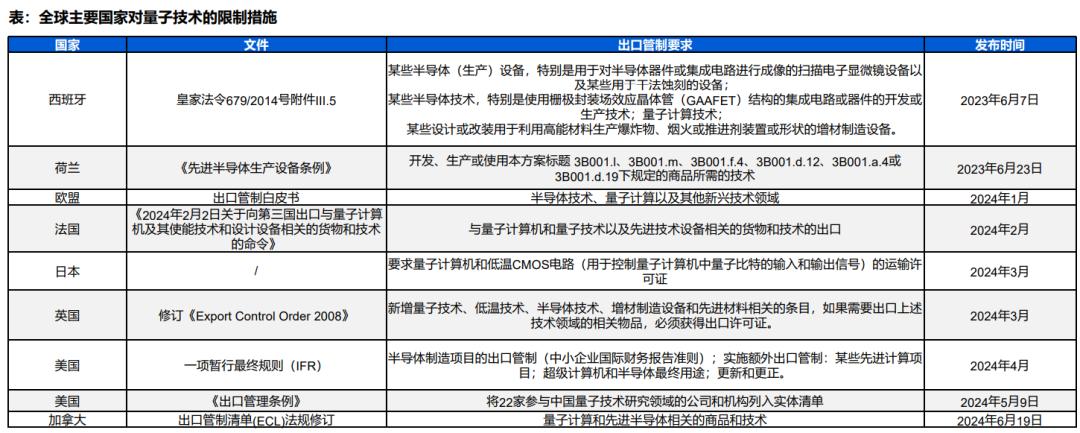
Figure: Export controls on quantum computing of various countries, Guohai Securities, AlphaEngine
Secondly, industrial giants are accelerating their layouts, and leading quantum computing companies are frequently obtaining huge amounts of financing.
On September 4th, 9th, and 10th, 2025, NVIDIA successively invested in Quantinuum under Honeywell, QuEra Computing, and PsiQuantum, covering the three major routes of ion traps, neutral atoms, and photonic quantum.
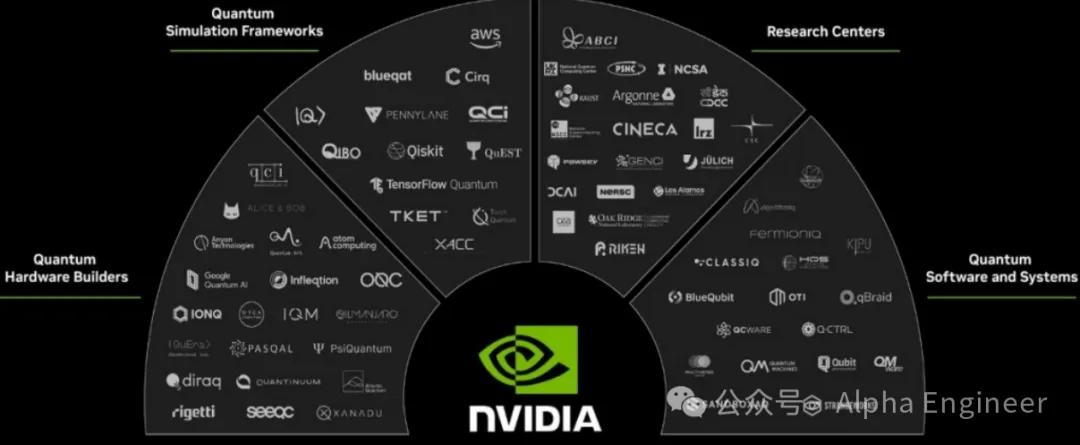
Take Quantinuum as an example. The company is controlled by Honeywell. After completing a financing of $600 million, the company’s valuation reached $10 billion.
This investment marks NVIDIA’s shift from the attitude of “commercialization will take decades” at the beginning of the year to active support, which also means that the quantum computing track has gained the endorsement of a giant, and the acceleration period of commercialization is coming.
In addition, on September 16, 2025, Bluefors’ official website announced a major order. Interlune will supply it with 10,000 liters of helium – 3 every year from 2028 to 2037 for the dilution refrigerators, the core equipment of quantum computing.
Calculated based on the annual consumption of 20 – 100 L of coolant per dilution refrigerator, this order can support the demand for 100 – 500 new devices per year, stockpiling resources in advance for the industrial application of quantum computing.
(3) Quantum Computing Technology Path: Photonic
Currently, the six mainstream technical routes adopted by the global quantum computing industry are: superconducting, ion trap, photonic, neutral atom, topological, and spin. Each technical path has its own advantages and disadvantages due to the different scientific essences of the computing methods, and no single technical route has formed an absolute dominance.
In terms of maturity, superconducting ≈ ion trap > photonic ≈ neutral atom > spin > topological.
In the previous part, we introduced the superconducting and ion trap technical paths. Now let’s analyze the remaining four.
Please refer to the following table for a detailed comparison of the six quantum computing paths. The content is quite technical, so you can save it and read it slowly.

Figure: Comparison of quantum computing technology paths, BofA, AlphaEngine
Photonic quantum computing uses photons as information carriers. Its core principle is to use the rich physical degrees of freedom of photons (such as polarization, path, time, frequency, etc.) to encode quantum bits (Qubit).
Different from the routes that rely on matter to construct quantum bits, this technology precisely manipulates the quantum states of photons through linear optical elements (such as beam splitters and phase modulators) to achieve quantum logic gate operations and information processing.
This method avoids direct manipulation of material particles, providing a unique physical implementation path for building quantum computers.
The photonic quantum route has an extremely long bit coherence time and strong anti – environmental interference ability, and theoretically can achieve extremely high fidelity.
Secondly, this system can operate at room temperature without expensive and complex ultra – low – temperature dilution refrigeration equipment, significantly reducing hardware costs and operational complexity.
Thirdly, photons are naturally compatible with existing fiber – optic communication networks, facilitating the construction of distributed quantum computing and quantum internet.
In recent years, the photonic quantum computing route has made significant progress in both solving specific problems and commercial exploration.
The “Jiuzhang 3” photonic quantum computing prototype developed by the team of the University of Science and Technology of China has continuously refreshed the world record in dealing with the Gaussian Boson Sampling problem, verifying the great potential of the photonic quantum route in achieving “quantum computational supremacy”.
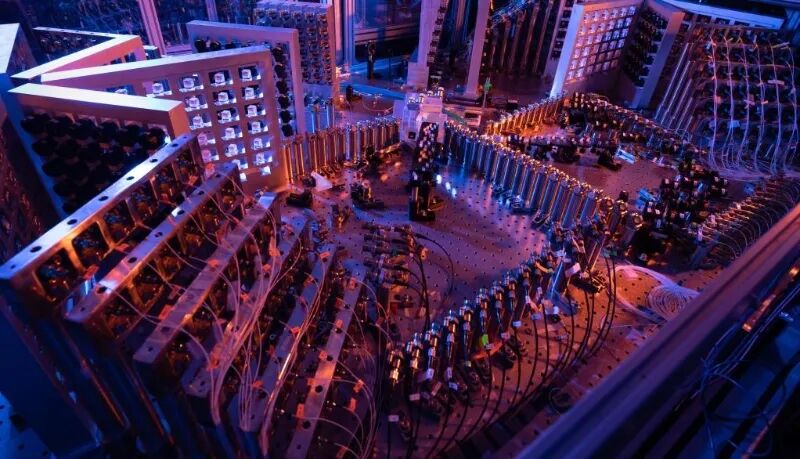
Companies represented by QCi are accelerating the commercialization process. Products such as the Dirac series of quantum optimizers and entropy quantum computing systems developed based on their patented photonic technology have been launched into the market.
Meanwhile, companies such as PsiQuantum are also actively demonstrating their large – scale and scalable computing platforms based on photons.
(4) Quantum Computing Technology Path: Neutral Atom
Neutral atom quantum computing is a technical route that uses lasers to precisely manipulate individual neutral atoms.
Its core principle is to use optical tweezers or optical lattices to trap and arrange a large number of neutral atoms (such as rubidium atoms and cesium atoms) in a vacuum, forming a highly ordered atomic array.
By using lasers to excite specific atoms to the high – energy Rydberg State, the volume of atoms in this state will expand rapidly, resulting in strong long – range interactions with other atoms.
This controllable interaction is used to construct quantum logic gates, achieve the encoding and manipulation of quantum bits, or directly simulate the evolution of complex quantum many – body systems.
The neutral atom route shows great potential in large – scale expansion and is one of the technical routes with the fastest – growing number of quantum bits at present.
A landmark achievement in 2025 was that Atom Computing released its neutral atom quantum computing prototype with a 1225 – atom array, the world’s first system publicly announced to break through a thousand quantum bits, establishing the leading position of this route in terms of scale.
Before this, the 49 – atom array of Harvard University and the 256 – atom prototype of QuEra had verified the feasibility of this technology.
Currently, domestic and foreign enterprises are accelerating their layouts, committed to improving the stable control technology of atomic arrays and promoting the transition of this technology from laboratory equipment to industrial – grade applications.
(5) Quantum Computing Technology Path: Spin
The core of the spin quantum computing route is to use the mature semiconductor process to fabricate nanoscale quantum dot structures on a silicon – based substrate (such as silicon – germanium alloy) to confine single electrons or holes.
This technology encodes information by using the spin quantum states (up or down) of electrons as quantum bits. By applying a voltage to the metal gate, the quantum bits can be fully electrically manipulated, and mechanisms such as electric – dipole spin resonance are used to initialize, flip (logic gate operation), and read out the quantum states.
The greatest strategic value of the spin route lies in its high compatibility with the existing CMOS (Complementary Metal – Oxide – Semiconductor) manufacturing process.
This means that the production of quantum chips can reuse the vast infrastructure, equipment, and supply chain accumulated by the global semiconductor industry over the decades to the greatest extent, providing a clear path for achieving ultra – large – scale integration and cost control.
The Tunnel Falls chip launched by Intel is a representative product of this route. It verifies the feasibility of fabricating quantum bit arrays on a 300mm wafer using advanced semiconductor processes, providing key support for the transition of quantum computing from the laboratory to large – scale industrial production.
(6) Quantum Computing Technology Path: Topological
The theoretical basis of topological quantum computing is highly subversive. Its core is to use the topological properties of matter rather than the physical states of individual particles to encode and process quantum information.
This route uses anyons, especially Majorana fermions or their zero – energy modes (Majorana Zero Modes), as the carriers of quantum bits.
Different from traditional quantum bits that store information in local physical properties (such as spin), the information of topological bits is non – locally encoded in the collective topological correlations of these quasiparticles.
The quantum computing process is executed by “braiding” the world lines of these quasiparticles in spacetime. This braiding operation is topologically stable, endowing the computing process with natural robustness.
The topological quantum computing route is still in the early experimental verification stage and has the lowest technical maturity. Microsoft is its main promoter.
The landmark progress was that Microsoft released the “Majorana 1” chip in February 2025. This chip uses a new topological core architecture. Its short – term goal is not to directly perform large – scale calculations but to experimentally verify the existence and effectiveness of topological protection features.
Although Microsoft has set a long – term goal of achieving the ability to solve industrial – grade problems within a few years, no fully functional topological quantum bits have been experimentally confirmed yet.
At present, Microsoft provides hybrid quantum cloud services through the Azure Quantum platform as a transitional commercialization strategy before the maturity of its topological route.
(7) Ecological Layouts of Tech Giants: IBM, Google, Microsoft, NVIDIA
After discussing the main technical paths of quantum computing, let’s sort out the latest layouts of the world’s major technology companies in the field of quantum computing.
Currently, the main participants in the quantum computing field can be divided into two categories: tech giants and specialized companies. The former focus on ecological layouts, while the latter try to make breakthroughs in specific areas. Let’s take a look at them separately.
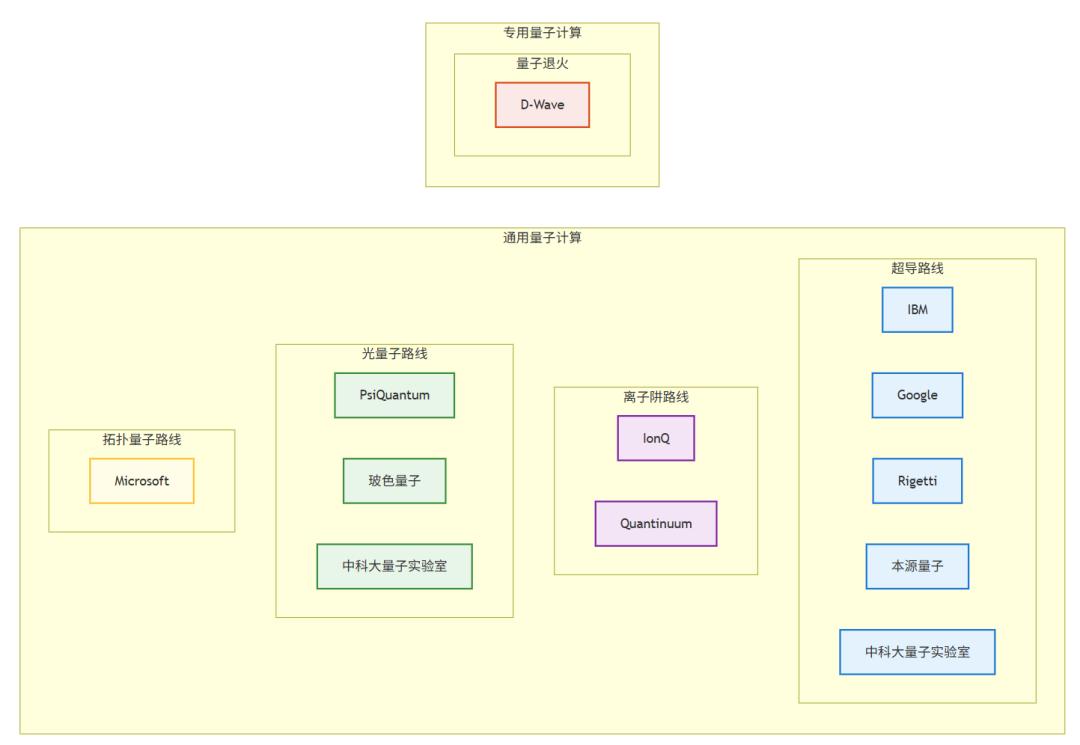
Figure: Classification of quantum computing companies, AlphaEngine FinGPT mapping
As the long – term leader in the superconducting route, IBM’s strategic core is to continuously iterate along a clear hardware roadmap to achieve commercial – grade fault – tolerant quantum computing.
The company has launched the Nighthawk processor with 120 quantum bits and plans to deliver the Starling system with 200 logical quantum bits in

